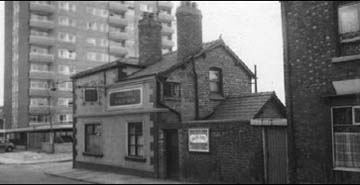 Oulton Place: The Barley Mow Inn (no 2 Oulton Place, illustrated right). Reader Peter Wright kindly wrote to tell us, "It was a Walkers Brewery pub, situated at the bottom of the small hill at the Delamere Street end of St. Anne Street. That small hill is still there now, it was on the site of that new old people's home currently under construction adjacent to the inner ring road... so the location of the pub was at the junction of St. Anne Street. and Oulton Place (the other end of Oulton Place is still there, that little side-street next to George St. school)". The licencee in 1919-20 was D Clements and in 1934-5 was D W Clements (the same chap?). Oulton Place: The Barley Mow Inn (no 2 Oulton Place, illustrated right). Reader Peter Wright kindly wrote to tell us, "It was a Walkers Brewery pub, situated at the bottom of the small hill at the Delamere Street end of St. Anne Street. That small hill is still there now, it was on the site of that new old people's home currently under construction adjacent to the inner ring road... so the location of the pub was at the junction of St. Anne Street. and Oulton Place (the other end of Oulton Place is still there, that little side-street next to George St. school)". The licencee in 1919-20 was D Clements and in 1934-5 was D W Clements (the same chap?).
Another photograph of the Barley Mow may be seen in our gallery.
At the other end of Oulton Place, on the corner of George Street and facing the Cattle Market, was The Farmers Arms. You can see it in this detail from the 1875 Chester OS map.
Overleigh Road: Pubs here are listed under Handbridge
Park Street: The Council House Beer House was trading here in 1840, licencee Eliza Hodkinson.
Pepper Street: The Red Lion (corner of Bridge Street, across the road from St. Michael's Church. Since the coming of the Inner Ring Road, this prominent site has been occupied by the large and ugly office block / hairdressers premises, Windsor House. Denny Colley wrote to us in August 2002 asking if we had any photographs of the old Lion as she was born there in 1944. "My aunt was the licensee but in partnership with my father. It's a shame that they pulled it down, it still had the stables at the back where the coach horses where housed". If anyone can help, contact her direct: dennycolley@onetel.net.uk. You can see a nice old colour picture of this corner as part of our Bridge Street entry...
The Albion appears in the 1857 Post Office Directory of Cheshire, licencee W Owens.
The Mitre Inn stood "at the south west corner of Pepper Street" and it appears in the will of Joseph Basnett in 1694. John Barker was licencee from 1782 to at least 1789. Its sale was recorded in 1811 when the landlord was William Lloyd. He must have 'come with the premises' as he was still there in 1828. William Hughes was in charge in 1840 and John Davies is also listed for that year (when it was called The Mitre Tavern). The Mitre seems to have ceased trading soon after 1846. It was recorded as being used as a polling station in 1809. Another Mitre was trading in St. Werburgh Street in 1828.
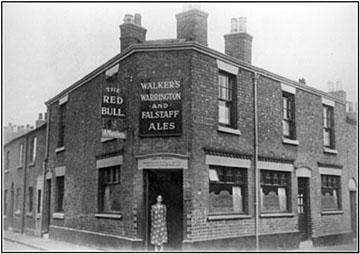 Pepper Alley: The sign and licence of the ancient Three Crowns Inn in Northgate Street- first recorded in 1272- was transferred here when the old inn was demolished to make way for Thomas Harrison's Commercial News Rooms in 1808. W Wilkinson is recorded in Pigot's Directory for 1818-20 as being the licencee and George Foster in 1822-3. Around 1831 its name was changed to The Bridgewater Tavern and it remained that in 1856. Pepper Alley: The sign and licence of the ancient Three Crowns Inn in Northgate Street- first recorded in 1272- was transferred here when the old inn was demolished to make way for Thomas Harrison's Commercial News Rooms in 1808. W Wilkinson is recorded in Pigot's Directory for 1818-20 as being the licencee and George Foster in 1822-3. Around 1831 its name was changed to The Bridgewater Tavern and it remained that in 1856.
“No poems can live long or please that are written by water-drinkers.” Horace 65 BC
Pitt
Street: The Red Bull Inn (left: corner of Thomas Street). Our photograph shows it in 1899. The licencee in 1919-20 was J Whelan.
Reader Peter Wright wrote to tell us, "When I grew up in the early 50s the Red Bull was actually Deponeo's chip shop. We lived next door at No 1 Pitt Street. You can actually just about see our front door, on the extreme right of the picture... brings back memories of the constant smell of fish and chips..."
Princess Street: The Crown & Anchor (no. 7) In 1818 the Crown's licencee was T Lawson, in 1822-3 W Jones, in 1828 John Kendrick, in 1840 Charles Blake, in 1850 Jas Colecough, in 1855 Thomas Rimmer, in 1857 Mrs E Matthews, in 1871 Mrs Conde, in 1880 William Fisher, in 1910 John William Watson, in 1914 it was Joseph Kelsal, in 1919-20 J Watson (the same chap as in 1910?) and in 1934-6 Mrs Margaret Bertram.
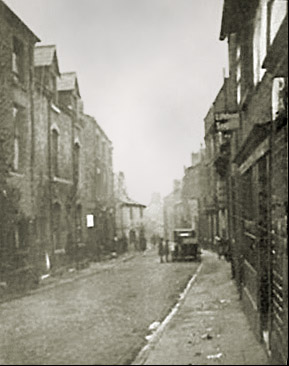 The Ancient Shepherd's Arms was at no 9 Princess Street, next door to the Crown & Anchor. In 1870 the licencee was James Carter (Chester Directory), in 1874/5 William Bailey (Morris and Co.'s Directory and Gazetteer of Cheshire), in 1878 Mary Ann Bailey (Post Office Directory of Cheshire), in 1883 John Williamson (Slater's Directory of N and S Wales etc). It was sometimes called the Shepherd's Arms and sometimes called the Ancient Shepherd's Arms. The Ancient Shepherd's Arms was at no 9 Princess Street, next door to the Crown & Anchor. In 1870 the licencee was James Carter (Chester Directory), in 1874/5 William Bailey (Morris and Co.'s Directory and Gazetteer of Cheshire), in 1878 Mary Ann Bailey (Post Office Directory of Cheshire), in 1883 John Williamson (Slater's Directory of N and S Wales etc). It was sometimes called the Shepherd's Arms and sometimes called the Ancient Shepherd's Arms.
The Chester Courant of 17th April 1821 reported a court case involving The Chequers Inn in Princess Street.
The Swan With Two Necks is listed in Cowdroy's Directory in 1782, its licencee being Edward Lloyd. Another inn with the same curious name once traded in Bridge Street.
In the United Kingdom, swans have traditionally been the property of the reigning Monarch. However, in the 16th century, Queen Elizabeth I granted the right to ownership of some swans to the Worshipful Company of Vintners. In order to be able to tell which Swan belonged to whom, it was decided that Vintners' swans should have their beaks marked with two notches, or nicks. In those days, 'neck' was another form of 'nick' and so the Vintners spotted that a 'Swan With Two Necks' could afford them a rather clever pun, and a striking pub sign.
The Coachmaker's Arms (no.14) stood directly opposite the Crown & Anchor midway down the street. In 1840 its licencee was Joseph Saddler, in 1850-57 it was William Jones.
The inn does not appear in the 1871 directory.
It was mentioned in the Cheshire Observer in September 1969.
Right: Princess Street as it was in 1930 and, below, is today- a cheerless place indeed, a victim of 20th century 'improvements' and 21st century prevarication, with the ugly bulk of the Market Hall and Council Offices on one side and, for the moment, the Bus Station on the other.
The vast and controversial Northgate Development is planned to rise on this site- a project which, at the time of writing, has been dithered over for well over a decade without a single brick being laid. Buildings were demolished in preparation for the new development but their site has now been laid out as an attractive, but temporary, park.
The Coach House Inn- the old Coach & Horses- still thrives on the corner but otherwise, not a single pub exists in the vicinity of Princess Street today.
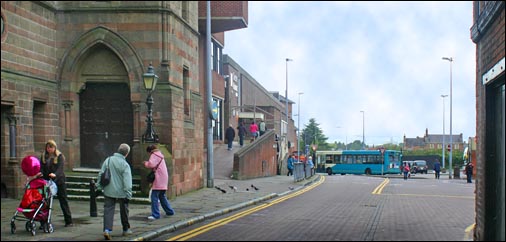 The Victoria Tavern. Mentioned in the Chester Chronicle 5th January 1838. The Victoria Tavern. Mentioned in the Chester Chronicle 5th January 1838.
The Horse & Jockey (no 33). Landlady in 1902 Mrs Martha Swindley, who was still there in 1920, in 1934 to at least 1936 Mrs Emma Taylor.
The Market Vaults. Slater's Directory lists an inn simply called The Market trading in Market Square in 1880 (licencee Jas. Whitefoot). Where they the same place?
The Town Hall Vaults (nos 1 and 3). Landlord in 1871 Thomas Pritchard, in 1902 Robert W Jones, in 1910-20 T H Jenkins, in the early 1930s Mr Thomas Shrives Evans. His grandson, Ian Palin in Blacon wrote to us, "My granddad, Mr Thomas Shrives Evans, was the landlord of a few pubs in his time, his first was the Town Hall Vaults in Princess Street. Then he had the London Bridge Hotel in Bridge Street then went to the Royal George Hotel, George Street in the 1940s. He died there in 1952". The licencee in 1934 was G H Nelson.
The Three Tuns (named for the armorial bearings of the three barrels of the Vintners' Company). The first tavern on the right after entering the street from the Market Square. An old house, first recorded in the 17th century, Sarah Bennett being the licencee in 1668. It is listed in Cowdroy's Directory in 1782, its licencee being J Keeling. It was recorded as being used as a polling station in 1809. Pigot's Directory for 1818-20 gives the licencee as Jonathan Keeling (who was still there in 1823). In 1828/9, according to the same, it was John Sant.
Sometime between 1829 and 1840 it changed from The Three Tuns to The Black Lion, followed by The Lion, and then became The Pig & Whistle Tavern by around 1840 with landlord Robert Jones. It then continued as The Pig & Whistle until around 1860, and then for a period between 1860 and 1870 it changed it's name to The Cabinet Maker's Arms with the attractively-named landlady Faithful Henshall, before reverting back to The Pig & Whistle again by 1871 with landlord Samuel Cooke.
Author and guide Thomas Hughes, writing in 1856, commented that "the present holder, having regard, one might suppose, to the swinish character of his guests, mercilessly "staved in" the Three Tuns and put up in their stead the whimsical sign of the PIG & WHISTLE". The head of a pig was a popular inn sign as far back as Pompeii, where it commonly was to be found, inviting its human hogs to enter, but that of the 'Pig & Whistle' dates from our Saxon ancestors and is a corruption of 'Peg & Wassail Bowl'. In those distant times, strong drink would be enjoyed from a common bowl and pegs were inserted at regular intervals into the vessel to indicate the quantity to be imbibed by each drinker. The still-common phrase 'to takes someone down a peg" also has its origins here."
Around 1883 the inn changed it's name once again to The Manchester Arms, whose licencee in 1891 was Frank Killimede and his sister Anne, in 1902 John Bolesworth, in 1910-14 Thomas Murray, in 1919-20 Minnie Priest. A fine image of the Town Hall Vaults and Manchester Arms may be seen in our Lost Pubs Gallery..
The
Rising Sun changed its name to The Oddfellow's Arms sometime in the mid-19th century and it is listed as such in the Chester Trades Directory in 1850 when its licecee was Mary Burton, Slater's Directory 1855 showing Mary Burton still in residence, the Post Office Directory 1857, licencee C E Davies, and in Slater's 1880, licencee Maria Young.
It is listed in Pigot's Directory 1828-1829 when it was called The Sun, the licencee being Mary Tapley. Ten years earlier, The Sun appeared in Pigot's 1818-20 Directory, licencee Joseph Sadler. It 1822 it was Margaret Tapley, in 1840, known as The Sun Tavern, it was run by Robert Rogers.
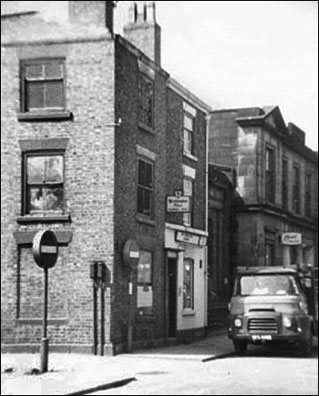 The Tanner's Arms. Listed in Pigot's Directory 1828-1829 when the licencee was Ann Parry. The Tanner's Arms. Listed in Pigot's Directory 1828-1829 when the licencee was Ann Parry.
The Farmer's Arms is listed in Pigot's Directory 1818-20 when the licencee was Charles Speed. In 1822-3 it was C Healy.
The Pig & Whistle Tavern is listed in the Chester Trades Directory in 1850 and Slater's Directory 1855 when its licencee was in both instances was Robert Jones.
He was there in 1840. Samuel Cooke had the place in 1871.
"Malt does more than Milton can
To justify God's ways to man".
A E Houseman: 'A Shropshire Lad'
Queen Street: The Plumbers Arms (no. 39), the site is now built over by the Tesco and British Home Stores rear entrances as well as Union Walk. Our photograph, right, shows it in 1971. The facade of the classical building, the former Independent Chapel of 1777, to its right still survives. The licencee from 1919 was J Williams, in 1936 James Bartlett. Another photograph of the pub may be seen in our gallery.
The Britannia Inn (no. 11- but the 1859 Post Office Directory of Cheshire says no.6). Landlord in 1850 Charles Weaver, in 1859 Mrs E Peake, in 1880 John Evans (curiously, a John Evans is also listed in Slater's as licencee in 1855 and also in 1871. If he was here 1855-80, how do those other licencees fit in?) In 1902 Walter Bevins, in 1910-1920 Mrs Sarah Price (mentioned in 1919-20 trade directory as S Price).
The Drum Major appears in Pigot's Directory for 1818-20 when its licencee was W Evans.
The Queen Street Tavern - recorded as being used as a polling station in 1809. Elen Huntinton was the landlady in 1822-3.
The Grosvenor Arms is listed in Pigot's Directory for 1828/9 when the licencee was Edward Morgan.
He had been there in 1822-3.
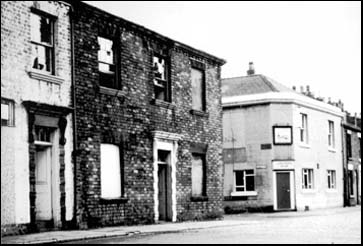 Saltney: The Railway Inn (illustrated left) No.3 Wood Street, on the corner of Cable Street, directly below Saltney Station, which was on top of the embankment opposite (on the right of the photo, out of shot). It opened in 1852 as self-owned pub and was taken over by Greenalls in 1880. It was known locally as 'The Engine'. The licencee in 1857 was E Pugh, in 1880 was Edward Richards, in 1902 Charles Bennett, in 1910-1914 Mrs E Bennett. The last licencee was Henry Jones whose brother Tommy had the Brewery Arms, 36 Chester Street. Their father had originally owned both pubs. The photo shows it sitting empty and derelict prior to demolition in 1966. The area has long since been redeveloped into a modern housing estate surrounding Shrewsbury Way. Saltney: The Railway Inn (illustrated left) No.3 Wood Street, on the corner of Cable Street, directly below Saltney Station, which was on top of the embankment opposite (on the right of the photo, out of shot). It opened in 1852 as self-owned pub and was taken over by Greenalls in 1880. It was known locally as 'The Engine'. The licencee in 1857 was E Pugh, in 1880 was Edward Richards, in 1902 Charles Bennett, in 1910-1914 Mrs E Bennett. The last licencee was Henry Jones whose brother Tommy had the Brewery Arms, 36 Chester Street. Their father had originally owned both pubs. The photo shows it sitting empty and derelict prior to demolition in 1966. The area has long since been redeveloped into a modern housing estate surrounding Shrewsbury Way.
The Brewery Arms 36 Chester Street. Licencee in 1936, Mrs Jones.
The Red Lion (High Street) was opened 1860 as self-owned pub, but was taken over by Northgate Brewery around 1875. The building now houses a tile shop/fireplace shop. The landlord in 1880 was Thomas Blayney, in 1902 it was Charles Lovatt, who was still there in 1914, in 1920 and 1934 C Lovatt (the same chap 1902-34?) You can see The Red Lion in the foreground and The Neptune Inn (below) behind on this old postcard.
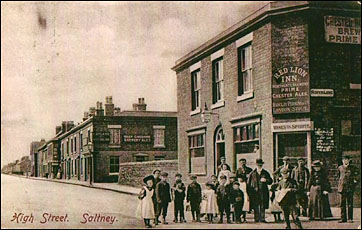 The Neptune Inn was opened in 1851 as a West Cheshire Brewery House but taken over by Threlfalls in the 1920s. Its landlord in 1880 was John Jones, in 1902-1910 Arthur Ryland, in 1914 to at least 1920 Isaac Lovatt, in 1934-5 H Mountford. Now houses Foden's DIY store. The Neptune Inn was opened in 1851 as a West Cheshire Brewery House but taken over by Threlfalls in the 1920s. Its landlord in 1880 was John Jones, in 1902-1910 Arthur Ryland, in 1914 to at least 1920 Isaac Lovatt, in 1934-5 H Mountford. Now houses Foden's DIY store.
The Farmers Arms was opened 1860 as a Birkenhead Brewery house. Its license ceased in 1932 and it was eventually demolished in 1972 to make way for new houses at Shrewsbury Way. Its licencee in 1902 was Michael Gibbons and in 1919-20 T Kelly.
The Prince of Wales was opened in 1860 as a Wilderspool Brewery house. It was hit by lightning in WW1 but survived, and eventually closed for good in 1966, and now replaced by a hairdresssers and a TV aerial shop. Licencee in 1880 Thomas Evans, in 1902 Joseph Ross, in 1910-1920 Mrs Margaret Ross, in 1934-5 E Morris..
The Queen's Hotel was opened 1869 as Yates house and demolished in 1960 as part of re-location work. It used to stand where industrial units are now, behind the Social Club. Licencee in 1880 Ellis Ryley, in 1902-1910 James Wood, in 1919-20 G Lovatt.
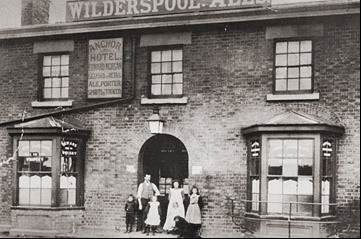 The Wellington Inn. Opened in 1860 as a Fox`s Brewery house (Ewloe) and closed in 1931 but not demolished until 1960, along with the Queens Hotel. It was located at the Bridge St / High St junction. Licencee in 1880 Charles Connah, in 1902 Thomas Gibbons, in 1910-1920 Mrs Catherine Law. The Wellington Inn. Opened in 1860 as a Fox`s Brewery house (Ewloe) and closed in 1931 but not demolished until 1960, along with the Queens Hotel. It was located at the Bridge St / High St junction. Licencee in 1880 Charles Connah, in 1902 Thomas Gibbons, in 1910-1920 Mrs Catherine Law.
The Anchor Hotel (1 High Street, illustrated left). Listed in Slater's Directory 1880. Licencee in 1914-1920 Edward Morgan (listed in a trades directory 1919-20), in 1934-42 Frederick Lane.
The Brewery Arms (36 Chester Street). Also listed in Slater's Directory 1880 when the licencee was Evan Jones. In 1910 Mrs Mary Jane Dodd was the licencee- when it was listed as The Brewery Hotel. In 1914 Thomas Henry Jones was the landlord.
The City Arms. (56 Chester Street). Mentioned in Slater's Directory 1880 when the licencee was James Knight. Kelly's Directory for 1910 lists the licencee as the splendidly-named Thomas Sydney Walter Poingdestre. In 1919-20 Thomas Ryeland, in 1934 J A Steen.
A 1936 pub directory lists The Last House in England as trading at 56 Chester Street, licencee J A Steen.
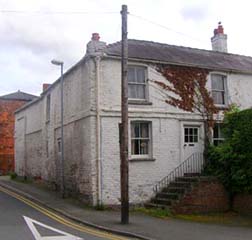 Sandy Lane: The White House (actual address 4 Dee Banks. A block of flats occupies the site today). This fine photograph, apparently of the 1930s, shows genteel customers of the 'White House Cafe' (the name is written on the wall) partaking of tea and cakes, with nary a pint or a short to be seen. See our Dee Banks entry for more about the White House and the nearby, still-surviving (albeit as an 'upmarket' bar / restaurant) Red House. Kelly's Directory says the licencee in 1952 was Mrs Annie Clark. Sandy Lane: The White House (actual address 4 Dee Banks. A block of flats occupies the site today). This fine photograph, apparently of the 1930s, shows genteel customers of the 'White House Cafe' (the name is written on the wall) partaking of tea and cakes, with nary a pint or a short to be seen. See our Dee Banks entry for more about the White House and the nearby, still-surviving (albeit as an 'upmarket' bar / restaurant) Red House. Kelly's Directory says the licencee in 1952 was Mrs Annie Clark.
Saughall:The Swinging Gate Inn traded for centuries on the corner of Church Road and Hermitage Road in Saughall. Its building is now a private residence- seen on the right, photographed in 2011. The inn's landlord in 1561 was George Martyn, in 1812 William Fenna, in 1820-28 William Wynne, in 1857 J Stubbs- when the pub was simply called The Gate, in 1860, Joseph Dunn. The licencee in 1902 was Mrs Mary Jones, who was still there in 1914. See an interesting old photograph of the place in our Vanished Pubs Gallery..
The Anchor-
rcorded in a list of alesellers in the Hundred of Wirral in 1822 when the licencee was Nathan Grimes.
The Stag's Head (possibly an early name of the still-thriving Greyhound Inn). An excellent history of the village is here. In November 2008, we heard that the Greyhound- or at least its restaurant- was to change its name to The Horned Woman, in honour of an unfortunately deformed villager of the 17th century.
"A quart of ale is a dish for a king." Shakespeare: 'A Winter's Tale'
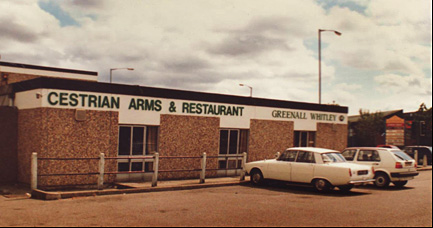 Sealand Road: The Cestrian Bar & Restaurant formed part of Chester City FC's ground on Sealand Road until it was relocated to Bumper's Lane and the site redeveloped as part of the Greyhound Retail Park (the dog track stood next door to the football ground). More details to follow- can you help? Sealand Road: The Cestrian Bar & Restaurant formed part of Chester City FC's ground on Sealand Road until it was relocated to Bumper's Lane and the site redeveloped as part of the Greyhound Retail Park (the dog track stood next door to the football ground). More details to follow- can you help?
Seller Street: The Crown Vaults (no. 33, corner of Canalside, now a private house, illustrated below in 2010), one of the canalside pubs founded in the 18th century to cater to the boatmen on the canal and the workers in the chemical works, sawmills, corn mills and other industrial establishments that once proliferated in this area. Reader Andy Johnson in Croydon wrote to tell us of his Great Great Grandfather, John Probert. He was born around 1845 in Walsall Staffordshire, and spent most of his early years in the Royal Artillery but finally landed in Chester around 1890/1 having achieved the rank of Sgt Major. In 1891 he was a widower living at 39 Pepper Street with his 8 children. From 1895 until at least 1901 he was the landlord of The Crown Vaults. He writes, "I would be particularly interested to hear if anyone knows any more about The Crown Vaults, is it now a take away? (see above) and if there are any photos about. Also, the address at 39 Pepper Street– was that or is it still a pub? Email me at andy@pleasantgrove.co.uk.
In 1910 the licencee was Thomas Gilbert Davies, in 1919-20 James Bagnall, in 1934 Mrs E Bagnall (his widow?)
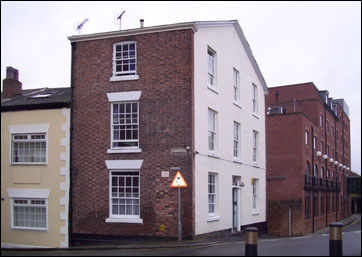 The Queen's Head Hotel- 1 Seller Street and 137 Foregate Street. Along with the Ring O' Bells and Grosvenor Park Hotel, it was demolished to make way for the Inner
Ring Road. Their site is now occupied by the Grosvenor Court offices and the City Road roundabout. A few fine pictures of the Queen's Head may be seen in our gallery. The Queen's Head Hotel- 1 Seller Street and 137 Foregate Street. Along with the Ring O' Bells and Grosvenor Park Hotel, it was demolished to make way for the Inner
Ring Road. Their site is now occupied by the Grosvenor Court offices and the City Road roundabout. A few fine pictures of the Queen's Head may be seen in our gallery.
The licencee in 1840 was Elizabeth Meakin. It was listed in the Chester Trades Directory in 1850 when the licencee was John Shaw, Slater's Directory 1855, licencee Jane Shaw and the Post Office Directory of Cheshire in 1857, licencee Thomas Walker (who was still there in 1871), in 1934 L Henderson.
“I recommend...bread, meat, vegetables and beer.” Sophocles: 'Philosophy for a balanced diet'
The Druids Arms. Reader Allen Blakeley kindly sent us this photograph of the old Druids. He tells us that "the girl on the step is my wife's grandmother, Phyllis Webb, who was born in 1900 so I guess the year is around 1905/6. Phyllis was the granddaughter of the licensee, James Moore, whose name can be clearly seen (above the door)".
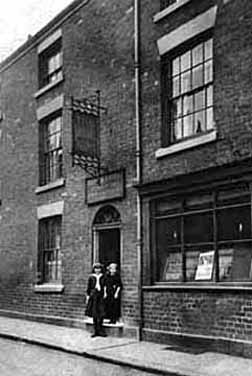 Allen later wrote to tell us that, "James Moore was a beer retailer in 1906 at 5 Seller Street and was the licensee from 1914 until 1923 at the Druid's, which was located just up the road at 16 Seller Street. He was employed by the Albion Brewery Company." Allen is keen to hear from anyone with information about the family. Allen later wrote to tell us that, "James Moore was a beer retailer in 1906 at 5 Seller Street and was the licensee from 1914 until 1923 at the Druid's, which was located just up the road at 16 Seller Street. He was employed by the Albion Brewery Company." Allen is keen to hear from anyone with information about the family.
In February 2012, Melanie Nicholson wrote to tell us, "I have an update for you on the Druid’s Arms in Seller Street. My OH’s grandmother lived there at the time she got married in 1921.
Now the the 1911 census is out, I can tell you that the Druid's was still a private house then, so Allen’s note that James Moore was the licensee from 1916 is possibly the time when the house became a pub. James was still a waggon maker for the railways in 1911 and the census lists it just as 16 Sellar Street".
Melanie has sent us a fascinating photograph, taken by her Father-in-Law, of the old Druid's just before its demolition. See it, and read more, in our 'lost pubs gallery' here...
Shipgate Street: The Royal Oak was mentioned in the Chester Directory of 1782 when its landlord was Gerard Jordan and in Pigot's Directory in 1828, licencee Reginald Tummons. An unnamed inn and garden in Shipgate Street was let by the city for a rent of 2 shillings per annum to one John Houghton in 1550.
Another, better known, Royal Oak long traded in Foregate Street and the fine building is still with us today, albeit as retail premises- of recent times a branch of electrical retailers Dixon's, then Curry's.
A branch of Waitrose moved in there in late 2011.
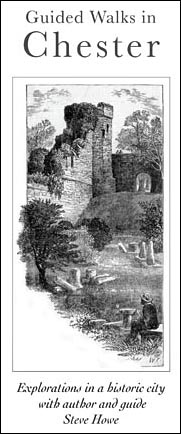 The French Horn. Listed as being "at the Shipgate". Appeared in Pigot's Directory 1818-20 when its licencee was Richard Simpson. He was still there in 1823. The French Horn. Listed as being "at the Shipgate". Appeared in Pigot's Directory 1818-20 when its licencee was Richard Simpson. He was still there in 1823.
Regular contributor 'exchesterstudent' believes The Royal Oak and The French Horn were actually the same inn: "In 1789 it was called The Royal Oak, but then there was no mention in the directories of it until 1828. There was also a pub called The French Horn in the directories in 1818 and 1822. It seems strange that the Royal Oak disappears for 30 years and then reappears. The usual explanation is that it changed it's name to something else in between. Having a look at the other pubs and beer houses on Shipgate shows the French Horn appearing only in the directories where the Royal Oak is missing. Of course, this doesn't necessarily mean that they are the same pub. It could just be coincidence, but the missing piece in the jigsaw was an article in the Chester Chronicle, 13th March 1829, when the licencee of The French Horn, Mr Tummons seems to have got himself into a spot of matrimonial bother and was recorded as appealing to the bench of the Chester Police Court "for instructions as to the course he should pursue towards his 'frail-rib"... He is listed in the 1828-1829 directory at The Royal Oak, yet there he is in court as the licencee of The French Horn. Given the fact that The French Horn appears where The Royal Oak is missing, this is 99% conclusive evidence that The French Horn = The Royal Oak".
The Millstone. Listed in Pigot's 1828-1829 Directory. A Millstone also appears under nearby Lower Bridge Street in this directory so may have been one pub situated at the junction of the two streets. However, the licencees names differ; Thomas Ball at the Lower Bridge Street Millstone and Charles Hilditch in the Shipgate Street one...
The Old Edgar, on the corner of Lower Bridge Street dates from around 1500. After years of dereliction it was restored and now serves as a private residence. In 1828, when it was called The Edgar Tavern, its licencee was John Moulton, in 1850 George Owens, in 1857 T Rimmer. A 1905 postcard advertised The Edgar Tavern, as it was then still called, as offering "refreshment rooms and accomodation for cyclists". The 1871 census lists the inn under the name The King Edgar.
The Hole in the Wall was listed in Cowdroy's Directory in 1785 when the licencee was William Thomas- who was still there in 1789. Pigot's Directory for 1818-20 shows Mary Massey in charge (she was still there in 1823).
Advertisement from Adams’s Weekly Courant, 1 July 1783: "To be LET, And entered upon immediately, AN old-accustomed Public-House, in Shipgate-street, near the Bridge, known by the Name of the HOLE-IN-THE-WALL, with good Cellaring, Brewhouse, and other Conveniences for brewing of Ale. Inquire of John Ridgway, Malster, who has for Sale, Fine old Jamaica RUM, neat as imported".
Sluices Sealand: The Chester Trades Directory for 1840 names a publican named Mrs Dixon trading in this curiously-named place.
Souter's Lane: The Newgate Tavern
Back to parts 1 | 2 | 3 | 4 | 5 On to parts 7 | 8 | gallery | old pubs maps | The Living Pubs of Chester |
 Oulton Place: The Barley Mow Inn (no 2 Oulton Place, illustrated right). Reader Peter Wright kindly wrote to tell us, "It was a Walkers Brewery pub, situated at the bottom of the small hill at the Delamere Street end of St. Anne Street. That small hill is still there now, it was on the site of that new old people's home currently under construction adjacent to the inner ring road... so the location of the pub was at the junction of St. Anne Street. and Oulton Place (the other end of Oulton Place is still there, that little side-street next to George St. school)". The licencee in 1919-20 was D Clements and in 1934-5 was D W Clements (the same chap?).
Oulton Place: The Barley Mow Inn (no 2 Oulton Place, illustrated right). Reader Peter Wright kindly wrote to tell us, "It was a Walkers Brewery pub, situated at the bottom of the small hill at the Delamere Street end of St. Anne Street. That small hill is still there now, it was on the site of that new old people's home currently under construction adjacent to the inner ring road... so the location of the pub was at the junction of St. Anne Street. and Oulton Place (the other end of Oulton Place is still there, that little side-street next to George St. school)". The licencee in 1919-20 was D Clements and in 1934-5 was D W Clements (the same chap?). 
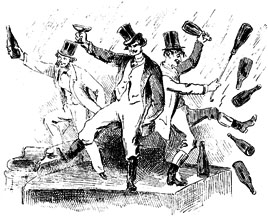

 The Ancient Shepherd's Arms was at no 9 Princess Street, next door to the Crown & Anchor. In 1870 the licencee was James Carter (Chester Directory), in 1874/5 William Bailey (Morris and Co.'s Directory and Gazetteer of Cheshire), in 1878 Mary Ann Bailey (Post Office Directory of Cheshire), in 1883 John Williamson (Slater's Directory of N and S Wales etc). It was sometimes called the Shepherd's Arms and sometimes called the Ancient Shepherd's Arms.
The Ancient Shepherd's Arms was at no 9 Princess Street, next door to the Crown & Anchor. In 1870 the licencee was James Carter (Chester Directory), in 1874/5 William Bailey (Morris and Co.'s Directory and Gazetteer of Cheshire), in 1878 Mary Ann Bailey (Post Office Directory of Cheshire), in 1883 John Williamson (Slater's Directory of N and S Wales etc). It was sometimes called the Shepherd's Arms and sometimes called the Ancient Shepherd's Arms.
 The Victoria Tavern. Mentioned in the Chester Chronicle 5th January 1838.
The Victoria Tavern. Mentioned in the Chester Chronicle 5th January 1838. The Tanner's Arms. Listed in Pigot's Directory 1828-1829 when the licencee was Ann Parry.
The Tanner's Arms. Listed in Pigot's Directory 1828-1829 when the licencee was Ann Parry.  Saltney:
Saltney: The Neptune Inn was opened in 1851 as a West Cheshire Brewery House but taken over by Threlfalls in the 1920s. Its landlord in 1880 was John Jones, in 1902-1910 Arthur Ryland, in 1914 to at least 1920 Isaac Lovatt, in 1934-5 H Mountford. Now houses Foden's DIY store.
The Neptune Inn was opened in 1851 as a West Cheshire Brewery House but taken over by Threlfalls in the 1920s. Its landlord in 1880 was John Jones, in 1902-1910 Arthur Ryland, in 1914 to at least 1920 Isaac Lovatt, in 1934-5 H Mountford. Now houses Foden's DIY store. The Wellington Inn. Opened in 1860 as a Fox`s Brewery house (Ewloe) and closed in 1931 but not demolished until 1960, along with the Queens Hotel. It was located at the Bridge St / High St junction. Licencee in 1880 Charles Connah, in 1902 Thomas Gibbons, in 1910-1920 Mrs Catherine Law.
The Wellington Inn. Opened in 1860 as a Fox`s Brewery house (Ewloe) and closed in 1931 but not demolished until 1960, along with the Queens Hotel. It was located at the Bridge St / High St junction. Licencee in 1880 Charles Connah, in 1902 Thomas Gibbons, in 1910-1920 Mrs Catherine Law.  Sealand Road:
Sealand Road:
